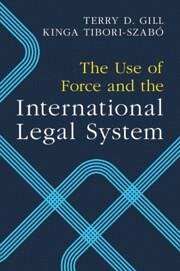Terry D. Gill (Universiteit van Amsterdam), Kinga Tibori-Szabo (Universiteit van Amsterdam)
The Use of Force and the International Legal System
Terry D. Gill (Universiteit van Amsterdam), Kinga Tibori-Szabo (Universiteit van Amsterdam)
The Use of Force and the International Legal System
- Broschiertes Buch
- Merkliste
- Auf die Merkliste
- Bewerten Bewerten
- Teilen
- Produkt teilen
- Produkterinnerung
- Produkterinnerung
This book provides accessible, in-depth coverage and analysis of how international law regulates the use of force through an intra-disciplinary perspective. Using a modernized legal positivist approach, it offers a unique focus on the relationship and functions of jus ad bellum within the wider legal landscape.
Andere Kunden interessierten sich auch für
![An Introduction to Public International Law An Introduction to Public International Law]() Cecily RoseAn Introduction to Public International Law34,99 €
Cecily RoseAn Introduction to Public International Law34,99 €![Making the World Safe for Investment Making the World Safe for Investment]() Andrea Leiter (Universiteit van Amsterdam)Making the World Safe for Investment119,99 €
Andrea Leiter (Universiteit van Amsterdam)Making the World Safe for Investment119,99 €![The Cambridge Handbook of Foreign Judges on Domestic Courts The Cambridge Handbook of Foreign Judges on Domestic Courts]() The Cambridge Handbook of Foreign Judges on Domestic Courts255,99 €
The Cambridge Handbook of Foreign Judges on Domestic Courts255,99 €![Contesting the World Contesting the World]() Contesting the World37,99 €
Contesting the World37,99 €![Legal Problems of International Organizations Legal Problems of International Organizations]() Felice MorgensternLegal Problems of International Organizations113,99 €
Felice MorgensternLegal Problems of International Organizations113,99 €![The World Crisis and International Law The World Crisis and International Law]() Stephan, Paul B., III (University of Virginia)The World Crisis and International Law30,99 €
Stephan, Paul B., III (University of Virginia)The World Crisis and International Law30,99 €![The values of international organizations The values of international organizations]() James D. FryThe values of international organizations105,99 €
James D. FryThe values of international organizations105,99 €-
-
-
This book provides accessible, in-depth coverage and analysis of how international law regulates the use of force through an intra-disciplinary perspective. Using a modernized legal positivist approach, it offers a unique focus on the relationship and functions of jus ad bellum within the wider legal landscape.
Produktdetails
- Produktdetails
- Verlag: Cambridge University Press
- Seitenzahl: 466
- Erscheinungstermin: 21. Dezember 2023
- Englisch
- Abmessung: 229mm x 152mm x 24mm
- Gewicht: 676g
- ISBN-13: 9781009407359
- ISBN-10: 100940735X
- Artikelnr.: 68442806
- Herstellerkennzeichnung
- Libri GmbH
- Europaallee 1
- 36244 Bad Hersfeld
- gpsr@libri.de
- Verlag: Cambridge University Press
- Seitenzahl: 466
- Erscheinungstermin: 21. Dezember 2023
- Englisch
- Abmessung: 229mm x 152mm x 24mm
- Gewicht: 676g
- ISBN-13: 9781009407359
- ISBN-10: 100940735X
- Artikelnr.: 68442806
- Herstellerkennzeichnung
- Libri GmbH
- Europaallee 1
- 36244 Bad Hersfeld
- gpsr@libri.de
Terry D. Gill is Emeritus Professor of Military Law at the University of Amsterdam and is a globally recognised authority on the law of armed conflict. He is founder and co-director of the Research Program on the Law of Armed Conflict and Military Operations (LACMO) at the Amsterdam Centre for International Law and is co-convenor of the Netherlands Research Forum on the Law of Armed Conflict and Peace Operations (LACPO).
Part I. Development of the Contemporary Jus ad Bellum in International Law:
1. Introduction; 2. From just war to the great war; 3. From the regulation
of war to the prohibition on the use of force; Part II. Scope and Content
of the Contemporary Jus ad bellum: 4. The prohibition on the use or threat
of force; 5. The use of force in the un collective security system:
maintenance and restoration of international peace and security through
collective measures; 6. The right of self-defence: essence, function and
legal foundation, requirements for exercise, scope and modalities of
application; Part III. Controversies and Contested Justifications for the
Use of Force: 7. Humanitarian intervention and the responsibility to
protect; 8. The use of force and the rescue and evacuation of nationals; 9.
Armed reprisals and the law on the use of force; 10. The use of force and
weapons of mass destruction; 11. New technologies of warfare and the law on
the use of force; Part IV. The Use of Force within the Wider Legal
Landscape: 12. The use of force as an attribute of state sovereignty; 13.
The use of force in the international commons; 14. The relationship of the
law on the use of force with the law of armed conflict and human rights
law; 15. International responsibility for the unlawful use of force:
states, organizations, armed groups and individuals; Part V. Concluding
Remarks: 16. Conclusions.
1. Introduction; 2. From just war to the great war; 3. From the regulation
of war to the prohibition on the use of force; Part II. Scope and Content
of the Contemporary Jus ad bellum: 4. The prohibition on the use or threat
of force; 5. The use of force in the un collective security system:
maintenance and restoration of international peace and security through
collective measures; 6. The right of self-defence: essence, function and
legal foundation, requirements for exercise, scope and modalities of
application; Part III. Controversies and Contested Justifications for the
Use of Force: 7. Humanitarian intervention and the responsibility to
protect; 8. The use of force and the rescue and evacuation of nationals; 9.
Armed reprisals and the law on the use of force; 10. The use of force and
weapons of mass destruction; 11. New technologies of warfare and the law on
the use of force; Part IV. The Use of Force within the Wider Legal
Landscape: 12. The use of force as an attribute of state sovereignty; 13.
The use of force in the international commons; 14. The relationship of the
law on the use of force with the law of armed conflict and human rights
law; 15. International responsibility for the unlawful use of force:
states, organizations, armed groups and individuals; Part V. Concluding
Remarks: 16. Conclusions.
Part I. Development of the Contemporary Jus ad Bellum in International Law:
1. Introduction; 2. From just war to the great war; 3. From the regulation
of war to the prohibition on the use of force; Part II. Scope and Content
of the Contemporary Jus ad bellum: 4. The prohibition on the use or threat
of force; 5. The use of force in the un collective security system:
maintenance and restoration of international peace and security through
collective measures; 6. The right of self-defence: essence, function and
legal foundation, requirements for exercise, scope and modalities of
application; Part III. Controversies and Contested Justifications for the
Use of Force: 7. Humanitarian intervention and the responsibility to
protect; 8. The use of force and the rescue and evacuation of nationals; 9.
Armed reprisals and the law on the use of force; 10. The use of force and
weapons of mass destruction; 11. New technologies of warfare and the law on
the use of force; Part IV. The Use of Force within the Wider Legal
Landscape: 12. The use of force as an attribute of state sovereignty; 13.
The use of force in the international commons; 14. The relationship of the
law on the use of force with the law of armed conflict and human rights
law; 15. International responsibility for the unlawful use of force:
states, organizations, armed groups and individuals; Part V. Concluding
Remarks: 16. Conclusions.
1. Introduction; 2. From just war to the great war; 3. From the regulation
of war to the prohibition on the use of force; Part II. Scope and Content
of the Contemporary Jus ad bellum: 4. The prohibition on the use or threat
of force; 5. The use of force in the un collective security system:
maintenance and restoration of international peace and security through
collective measures; 6. The right of self-defence: essence, function and
legal foundation, requirements for exercise, scope and modalities of
application; Part III. Controversies and Contested Justifications for the
Use of Force: 7. Humanitarian intervention and the responsibility to
protect; 8. The use of force and the rescue and evacuation of nationals; 9.
Armed reprisals and the law on the use of force; 10. The use of force and
weapons of mass destruction; 11. New technologies of warfare and the law on
the use of force; Part IV. The Use of Force within the Wider Legal
Landscape: 12. The use of force as an attribute of state sovereignty; 13.
The use of force in the international commons; 14. The relationship of the
law on the use of force with the law of armed conflict and human rights
law; 15. International responsibility for the unlawful use of force:
states, organizations, armed groups and individuals; Part V. Concluding
Remarks: 16. Conclusions.









